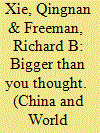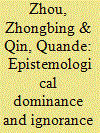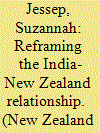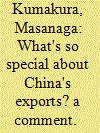|
|
|
Sort Order |
|
|
|
Items / Page
|
|
|
|
|
|
|
| Srl | Item |
| 1 |
ID:
103949


|
|
|
|
|
| Publication |
2011.
|
| Summary/Abstract |
This article investigates new opportunities that are emerging for Bangladesh with regard to her trade with India. In spite of the growing bilateral trade deficit, value of Bangladesh’s exports to India increased by about three times over the last five years. Examination of the dynamics of Bangladesh–India bilateral trade reveals that the number of products in Bangladesh’s export basket has registered significant increase, while at the same time, composition of the country’s exports to India has also shifted towards newer and non-traditional products. RCA analysis shows that export items with RCA > 1 in India, which include raw jute, chemical fertilizer, cement, RMG, leather, battery, textile fabrics and some other items, have significant export opportunities and have a combined potential market of US$ 2 billion in India. On the basis of examination of various tariff and nontariff barriers to trade with India, the article attempts to assess the economic implications of India’s sensitive list as it applies to Bangladesh, and argues that elimination of this list is not likely to have an adverse impact on India’s revenue earnings. The article also comes up with a number of recommendations to deal with the NTBs faced by Bangladesh in her trade with India, particularly in areas related to constraints arising from lack of trade facilitation.
|
|
|
|
|
|
|
|
|
|
|
|
|
|
|
|
| 2 |
ID:
164718


|
|
|
|
|
| Summary/Abstract |
China's advance to the forefront of scientific research is one of the 21st century's most surprising developments, with implications for a world where knowledge is arguably “the one ring that rules them all.” This paper provides new estimates of China's contribution to global science that far exceed estimates based on the proportion of papers with Chinese addresses in databases of international journals. Address‐based measures ignore articles written by Chinese researchers with non‐Chinese addresses and articles in Chinese language journals not indexed in those databases. Taking account of these contributions, we attribute 36 percent of 2016 global scientific articles to China. Taking account of increased citations to Chinese‐addressed articles relative to the global average as well, we attribute 37 percent of global citations to scientific articles published in 2013 to China. With shares of articles and citations more than twice its share of global population or GDP, China has achieved a comparative advantage in knowledge that has implications for the division of labor and trade among countries and for the direction of research and of technological and economic development worldwide.
|
|
|
|
|
|
|
|
|
|
|
|
|
|
|
|
| 3 |
ID:
112294


|
|
|
|
|
| Publication |
2012.
|
| Summary/Abstract |
This paper investigates the role of comparative advantage on biofuel policy adoption. Results show that different countries have different drivers to create biofuel policies. GDP proves to be more significant for OECD countries, while arable land and feedstock prices are more significant for non-OECD countries. Land allocation may also be of importance. We speculate that a naturally endowed comparative advantage may not necessarily equate to a successful biofuel industry.
|
|
|
|
|
|
|
|
|
|
|
|
|
|
|
|
| 4 |
ID:
126937


|
|
|
| 5 |
ID:
148694


|
|
|
|
|
| Summary/Abstract |
China, as an important source country in the global value chain, especially in the East Asian production networks, has exerted significant influence on Sino–Japanese trade fluctuations. This paper explores the real factors that lead to the fluctuations in Sino–Japanese trade. Using the Hodrick–Prescott filter technique and OECD–WTO Statistics on Trade in Value Added from 1995 to 2011, the impact of the changing comparative advantage between the two countries is also examined. The empirical results indicate that determinants of the fluctuations in Sino–Japapese trade include changing comparative advantages, the volatility of the real exchange rate and quite a few external shocks. Some policy suggestions are put forward in regards to the stability of trade between the two countries.
|
|
|
|
|
|
|
|
|
|
|
|
|
|
|
|
| 6 |
ID:
125812


|
|
|
|
|
| Publication |
2013.
|
| Summary/Abstract |
Electric power has traditionally been classified as a non-traded good, produced and consumed within the country of origin. More recently, electricity has been traded across national borders and in certain cases, viz., Bhutan, has been the dominant export; in other situations, it is used to repay debts owed to neighboring countries. This paper investigates the role of electricity as the primary export, analyzes its valuation, and then goes on to evaluate the impact on the terms of trade. We conclude that in the medium-term, the electric power exporting economy would be better off developing its manufacturing sector to diversify its exposure and to protect its trade interests.
The case of Bhutanese hydro-electricity exports to India is studied and the change in trade advantage with every increase in power tariff is ascertained. It is found that a 1.26% annual increase in (non-food) consumer prices is correlated with a 1% increase in electricity export tariff. While the causality from electric power tariff to Indian manufactures prices is not established statistically, a change in manufactures prices feeding back into consumer prices in Bhutan is statistically significant. Suggestions are offered for Bhutan to reduce dependence on Indian imports and to diversify its export market exposure.
|
|
|
|
|
|
|
|
|
|
|
|
|
|
|
|
| 7 |
ID:
171495


|
|
|
|
|
| Summary/Abstract |
This paper reports on a critical discourse analysis on a collection of international scientific journal articles, which are a critical edge of social epistemology. At the textual surface, the analysis finds that China's shale gas (SG) is compared most frequently with coal and energy imports but rarely with conventional natural gas (CNG) and coalbed methane (CBM), representing a prominent structure of epistemological dominance and ignorance. Situated in this structure there are four prevailing, albeit defective, reasoning forms. The prevalence of those forms suggests that there is a “knowledge deficit” on the comparative advantage of China's SG. This deficit concretely refers to that, the attention paid to the comparative advantage of China's SG toward CNG and CBM, the number of lifecycle-comparisons between energies, and the knowledge about the US shale gas boom, are significantly insufficient. China's energy mix, air quality and energy dependence, the conspicuousness of energy burning, and the nature of human thinking are interwoven factors of this deficit. The epistemological structure and thus the “knowledge deficit” are unfavorable for optimizing China's SG strategy and may delay natural gas' penetration into China's energy mix. This paper, especially its mental model representation, is awareness/introspection provoking to researchers and policy makers.
|
|
|
|
|
|
|
|
|
|
|
|
|
|
|
|
| 8 |
ID:
098056


|
|
|
| 9 |
ID:
166140


|
|
|
|
|
| Summary/Abstract |
There are differing views on the strengths and weaknesses of faith-based organizations relative to secular international nongovernmental organizations. This article argues that the theory of comparative advantage and the theory of organizational alignment are inadequate in helping to assess these strengths and weaknesses. The article offers a different perspective, called conduit engagement theory. It holds that humanitarian organizations naturally have specific relationships, organizational linkages, affiliations, or shared philosophies (referred to in the article as conduits) that enable certain programmatic interventions. Maximum effectiveness within the humanitarian marketplace is a function of the robustness of engagement of conduits with high-priority initiatives that have adequate funding over the necessary length of time. A new kind of tool for strategic planning within specific countries and for auditing at an organizational level are proposed.
|
|
|
|
|
|
|
|
|
|
|
|
|
|
|
|
| 10 |
ID:
086603


|
|
|
|
|
| Publication |
2009.
|
| Summary/Abstract |
Using panel data for 29 provinces in China during 1990-2004, the present paper attempts to explore a possible link between financial development and China's foreign trade. Three measures of comparative advantage in manufactured goods have been applied in our study, including Balassa's revealed comparative advantage, the net manufactured export index, and the Michaely index. We also use four indicators of financial development to identify the different functions of regional financial development, and to determine both size and efficiency features of financial institutions. The estimation results suggest that besides factor endowments, foreign firms and infrastructure, financial development has a quantitatively large and robust effect on China's manufactured goods trade. Therefore, further reform of China's financial system should be encouraged to fully exploit the comparative advantage of China's foreign trade.
|
|
|
|
|
|
|
|
|
|
|
|
|
|
|
|
| 11 |
ID:
166410


|
|
|
|
|
| Summary/Abstract |
Market demand is an important driver for inducing innovation, with many empirical studies supporting the demand-induced innovation hypothesis. Critiques of such studies, however, emphasize that new empirical evidence that can address existing empirical challenges is needed. Furthermore, existing literature disagrees about whether the locus of demand-pull policy matters. In this paper, we use empirical evidence from the distributed solar photovoltaic (PV) market in China to address the following questions: (1) Is there evidence of demand-induced innovation? (2) Does the effect of local demand-pull policy differ from the effect of non-local demand-pull policy on demand-induced innovation? To address these questions, we develop and analyze an original database of PV balance-of-system (BOS) patents in the distributed PV market filed between 2005 and 2014 in China. Our results support the demand-induced innovation hypothesis and suggest that only local demand significantly induces PV BOS innovations in the distributed PV market in China. The different effects of local demand and non-local demand emphasize the importance of local markets and local policies, lending some support to bottom-up approaches to clean energy governance.
|
|
|
|
|
|
|
|
|
|
|
|
|
|
|
|
| 12 |
ID:
077170


|
|
|
|
|
| Publication |
2007.
|
| Summary/Abstract |
If you are a voluntary conditional organization which can only spend about two pence per year on each citizen of your member countries, if you face growing competition for attention from other institutions, innovation in the management of all your assets, and particularly of your human capital, is absolutely vital for your survival. This article suggests building on the well established capacities of the Commonwealth to create a new form of networking. This includes a complete revision of the role of the Commonwealth Foundation so that the Commonwealth can harness the forces of civil society, and not only of Commonwealth NGOs, to the pursuit of the organization's goals
|
|
|
|
|
|
|
|
|
|
|
|
|
|
|
|
| 13 |
ID:
179176


|
|
|
|
|
| Summary/Abstract |
For a country on track to have the world's largest population by 2030 and one of the world's largest economies by 2050, there is no doubt that India will be consequential for New Zealand. Even if the trade relationship is put aside, India matters. It is also true that the relationship is set to become more complicated, as India grows and seeks to put its own mark on world affairs. But differences aside, India and New Zealand are clearly of strategic value to each other: in the Indian Ocean region, in the Pacific, in the Quad and as members of the wider Indo-Pacific region where many of India's values and interests directly align with New Zealand's.
|
|
|
|
|
|
|
|
|
|
|
|
|
|
|
|
| 14 |
ID:
159083


|
|
|
|
|
| Summary/Abstract |
This paper analyses how economic integration and the international division of labour have evolved among the ASEAN + 3 countries in the last 20 years. The paper proposes an indicator of the level of technological sophistication based on revealed comparative advantages and uses it to investigate the relation between technological advance, factor endowments and supply chain trade. It is shown that supply chain-trade does not facilitate technological transfer. On the contrary: FDI appears to have significant and negative spill-over effects on technological change. Positive spill-overs from FDI materialize only when host countries have sufficiently high levels of education.
|
|
|
|
|
|
|
|
|
|
|
|
|
|
|
|
| 15 |
ID:
143425


|
|
|
|
|
| Summary/Abstract |
Using annual data for the periods 1992–2012, this paper examines trade flows between China and its main trade partners in Asia, North America and Europe, and whether increasing trade has led to industrial structural adjustment and changes in China's trade patterns. The analysis is based on both economic indicators and the estimation of a gravity model, and applies recently developed panel data methods that explicitly take into account unobserved heterogeneity, specifically the fixed effect vector decomposition (FEVD) technique. The findings confirm the significant change in China's trading structure associated with the fast growth of foreign trade. In particular, there has been a shift from resource- and labour-intensive to capital- and technology-intensive exports.
|
|
|
|
|
|
|
|
|
|
|
|
|
|
|
|
| 16 |
ID:
079060


|
|
|
|
|
| Publication |
2007.
|
| Summary/Abstract |
Dani Rodrik argues that China's exports are unusually sophisticated for a country at its income level. He also claims that China's export sophistication reflects the government's successful industrial policy and has been instrumental in the recent acceleration of its economic growth. Although Rodrik's interpretation of China's economic growth is broadly correct, the accuracy of his empirical analysis is questionable. This note identifies several problems regarding the "export sophistication" index used in his empirical work and casts doubt on his analysis.
|
|
|
|
|
|
|
|
|
|
|
|
|
|
|
|
|
|
|
|
|